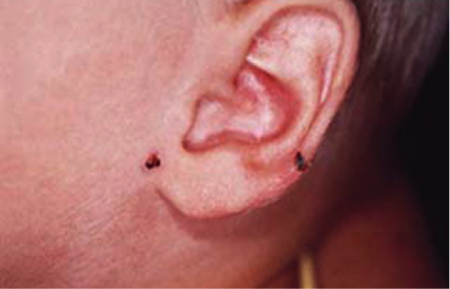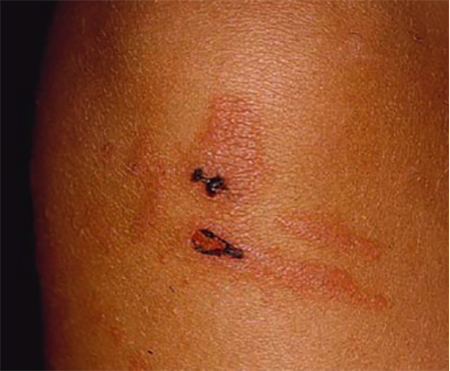Poison ivy, oak, and sumac: What does the rash look like?
While rare, some people see black spots instead of a red rash on their skin. These spots look like black lacquer spilled onto the skin. Instead of black spots, some people develop black streaks on their skin.
If you develop black spots or streaks, there tends to be little or no redness and swelling. The medical term for this condition is black-spot poison-ivy dermatitis.
Poison ivy rash
A rash from one of these poisonous plants usually shows up as red, itchy bumps on the skin.

Black-spot poison-ivy dermatitis
A few people develop black spots or streaks of black on their skin rather than a red rash.

Poison ivy rash: Streaks and spots
This 7-year-old boy developed red streaks and black spots.

How does the rash show up on the skin?
It takes time for the rash to appear. A rash can develop in a few hours if you’ve had a rash from one of these plants before. If you’ve never had a rash from poison ivy, oak, or sumac, it can take 2 to 3 weeks before you see a rash.
No matter how long it takes for the rash to appear, most people experience the following when they get a rash:
The skin itches intensely where the rash will appear. The itch can be so intense that it wakes you from a sound sleep.
Shortly after your skin starts to itch, the rash appears. Most people develop an itchy, red, and blistering rash.
If you have blisters, they break open and leak fluid.
The blisters crust over, and the rash clears in 2 to 3 weeks. The rash will clear without treatment, but it can be extremely itchy until it clears completely.
The intensity of the itch and severity of the rash can differ from person to person. Some people develop 1 or 2 small rashes. Others develop rashes all over.
Why does the rash from poison ivy, oak, or sumac spread?
While it may look like the rash is spreading, what’s most likely happening is that you’re developing one or more new rashes. This happens because you either:
Got urushiol (the oil from these plants that causes the rash) on more than one area of your skin. Typically, the skin with the most oil on it develops a rash first. Skin with less oil tends to react later.
Touched something that still has urushiol on it, such as the unwashed clothing you were wearing when you brushed up against one of these poisonous plants. Urushiol doesn’t have to be on the plant to cause a rash.
If your new rash appears near the current rash, it can look like the rash is spreading.
Many people also mistakenly believe that when they touch their rash, they can spread the rash from one part of their body to another. You cannot spread the rash.
If you have oil from the plant on your skin, you can spread the oil for a short time. Your skin absorbs the oil quickly, so you can only spread the oil from one part of your skin to another for a short amount of time.
How long does a rash from poison ivy, oak, or sumac last?
How long you have a rash depends on whether you’ve had a rash from one of these plants before. Here’s the general rule:
Previous rash from poison ivy, oak, or sumac: The rash tends to last 1 to 14 days before it clears on its own.
Never had a rash from poison ivy, oak, or sumac: You can have a rash for 21 days or longer before it goes away.
If you’re wondering why you develop a rash from these plants, you’ll find the answer at: Poison ivy, oak, and sumac: Who gets a rash, and is it contagious?
Images
Image 1 used with permission of the American Academy of Dermatology National Library of Dermatologic Teaching Slides.
Images 2,3 used with permission of the Journal of the American Academy of Dermatology.
J Am Acad Dermatol 2001;45:246-9.
References
Kurlan JG, Lucky AW. “Black spot poison ivy: A report of 5 cases and a review of the literature.” J Am Acad Dermatol 2001;45:246-9.
McGovern TW. “Dermatoses due to plants.” In: Bolognia JL, et al. Dermatology. (second edition). Mosby Elsevier, Spain, 2008: 255-6.
 Think sun protection during Skin Cancer Awareness Month
Think sun protection during Skin Cancer Awareness Month
 How to care for your skin if you have lupus
How to care for your skin if you have lupus
 Practice Safe Sun
Practice Safe Sun
 Sunscreen FAQs
Sunscreen FAQs
 Fade dark spots
Fade dark spots
 Hidradenitis suppurativa
Hidradenitis suppurativa
 Laser hair removal
Laser hair removal
 Scar treatment
Scar treatment
 Botox
Botox
 Kids' camp - Camp Discovery
Kids' camp - Camp Discovery
 Dermatologist-approved lesson plans, activities you can use
Dermatologist-approved lesson plans, activities you can use
 Find a Dermatologist
Find a Dermatologist
 Why choose a board-certified dermatologist?
Why choose a board-certified dermatologist?